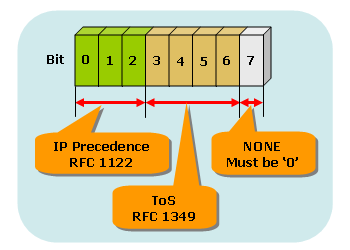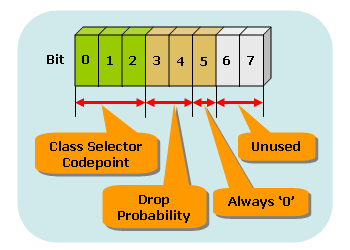QoS(Qaulity of Service) protocols were developed since data network demands efficiency of data delivery. Well known QoS protocols are RSVP, IntServ, DiffServ, MPLS, SBM and so on. In my opinion, just read thru and understand what those are. That would be enough unless you are crazy on QoS thoeory. There are a lot of information when you googling out there.
In practical world, most of time we will use DiffServ protocols and good to know about MPLS CoS as well.
1. Easy QoS 101 – What is QoS(Quality of Service)
2. Easy QoS 101 – QoS protocols
3. Easy QoS 101 – Queuing Techniques
4. Easy QoS 101 – Shaping & Policying
5. Easy QoS 101 – Queuing family
6. Easy QoS 101 – Congestion Avoidance
7. Easy QoS 101 – Applying QoS and examples
1. RSVP
The Resource ReSerVation Protocol (RSVP), described in RFC 2205, is a Transport layer protocol designed to reserve resources across a network for an integrated services Internet. "RSVP does not transport application data but is rather an Internet control protocol, like ICMP, IGMP, or routing protocols" – RFC 2205. RSVP provides receiver-initiated setup of resource reservations for multicast or unicast data flows with scaling and robustness.
RSVP can be used by either hosts or routers to request or deliver specific levels of quality of service (QoS) for application data streams or flows. RSVP defines how applications place reservations and how they can relinquish the reserved resources once the need for them has ended. RSVP operation will generally result in resources being reserved in each node along a path.
2. IntServ
The idea of IntServ is that every router in the system implements IntServ, and every application that requires some kind of guarantees has to make an individual reservation. Flow Specs describe what the reservation is for, while RSVP is the underlying mechanism to signal it across the network. IntServ or integrated services is an architecture that specifies the elements to guarantee quality of service (QoS) on networks. IntServ can for example be used to allow video and sound to reach the receiver without interruption.
3. DiffServ
Differentiated Services or DiffServ is a computer networking architecture that specifies a simple, scalable and coarse-grained mechanism for classifying, managing network traffic and providing Quality of Service (QoS) guarantees on modern IP networks. DiffServ can, for example, be used to provide low-latency, guaranteed service (GS) to critical network traffic such as voice or video while providing simple best-effort traffic guarantees to non-critical services such as web traffic or file transfers.
DiffServ has largely supplanted other Layer 3 QoS mechanisms (such as IntServ) as the primary protocol routers use to provide different levels of service.
(1) How DiffServ works

Classifier
– Packet will be classified into defined classes by ACL and class-map
Marking
– You can apply different weight or policy on each class by using policy-map
– IP precedence and DSCP were used on Layer 3 marking stratigy and 802.1p/Q, FR DE bit, MPLS EXP were used on Layer 2.
[1] IP precedence
– 3bits are used to make 8 different classes

IP Type of Service(RFC 791)
| precedence 0 precedence 1 precedence 2 precedence 3 precedence 4 precedence 5 precedence 6 precedence 7 |
000 001 010 011 100 101 110 111 |
Routine Priority Immediate Flash Flash Override Critical Internet Network |
[2] DSCP
– 6bits are used to make 21 different classes
– If value of drop probability is 01, probability is low.
– If value of drop probability is 10, probability is normal.
– If value of drop probability is 11, probability is high.

DSCP(Differentiated Services CodePrint)
|
Drop Probability |
Class 1 |
Class 2 |
Class 3 |
Class 4 |
|
Low |
001010 |
010010 |
011010 |
100010 |
|
Medium |
001100 |
010100 |
011100 |
100100 |
|
High |
001110 |
010110 |
011110 |
100110 |
Conditioner
– There is two methods that are shaping which is controlling traffic using queuing technique and policying which is restirctly traffic control by dropping packet.
Queuing
– FIFO, WFQ, CQ, PQ, CBWFQ, LLQ and etc.
– See article about "Easy QoS 101 – Queuing techniques"
4. MPLS
With the convergence of voice, video and data applications, business networks face increasing traffic demands. MPLS enables class of service (CoS) tagging and prioritization of network traffic, so administrators may specify which applications should move across the network ahead of others. This function makes an MPLS network especially important to firms that need to ensure the performance of low-latency applications such as VoIP and their other business-critical functions. MPLS carriers differ on the number of classes of service they offer and in how these CoS tiers are priced
5. SBM
SBM is stand for Subnet Bandwidth Management(Manager) which works like the RSVP protocol. It a top-to-bottom QoS approach and applies to data link layer. All traffic must pass at least one of switch or router that was enabled. SBM is described in RFC 2814 (SBM-Subnet Bandwidth Manager: A Protocol for RSVP-Based Admission Control over IEEE 802-Style Networks, May 2000).



 The www.ipBalance.com runs by a volunteer group with IT professionals and experts at least over 25 years of experience developing and troubleshooting IT in general. ipBalance.com is a free online resource that offers IT tutorials, tools, product reviews, and other resources to help you and your need.
The www.ipBalance.com runs by a volunteer group with IT professionals and experts at least over 25 years of experience developing and troubleshooting IT in general. ipBalance.com is a free online resource that offers IT tutorials, tools, product reviews, and other resources to help you and your need.

![[Splunk] – Basic search fields and commands logo_splunk.png](https://ipbalance.com/wp-content/uploads/2009/06/logo_splunk-100x80.png)

